FROM BODY CELL TO GENES & DNA
FROM BODY CELL TO GENES & DNA is an essay which explains from the beginning till end everything from the bigger level of a Cell to a smaller levels of GENES (ALLELES) & DNA.
- A human body is made up of cells. Each cell has a nucleus. Each nucleus contains tightly packed thread like structures – called chromosomes.
- In the human beings there are 23 pairs of chromosomes. A pair of chromosomes consists of two chromosomes so that each one of them is received from each of the two parents.

- Portions of the chromosomes are called Genes. A human being carries almost 20,000 to 25,000 genes in his biological structures called Genome. Hence, each chromosome contains roughly around 1000 genes on it.
- These portions of chromosome i.e. The Genes are made up of DNA.
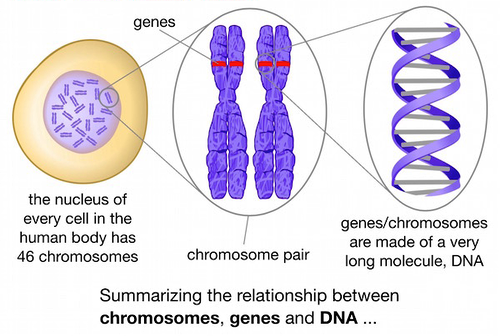
- The structure of DNA consists of two spiral Helices (pl. of Helix) complimenting each other. The material of Helices of DNA is a set of sugar molecules, bonded to a phosphate group on one end and to a Nitrogenous base on the other. This is shown in the images below:

- In this image P is the phosphate group, S is the sugar molecule and A, C, G and T are the nitrogenous bases. Their names are A (adenine), C (cytosine), G (guanine), T (thymine). In the structure of DNA base A is always connected to base T, and base C to the base G. This basic building block of the DNA (containing Phosphate group P + Sugar S + Corresponding Nitrogenous Base A, C, G, T) is called a Nucleotide.
- In professional work, only the variable parts A, C, G and T are shown in place of full structure of a nucleotide. Hence, to represent the four basic building blocks of DNA i.e. the nucleotides only their representative letters A, C, G and T are used. They are also called base pair or bp.
- Now for the basic understanding, it can be said that the DNA is made up of a long chain of nucleotides or bp. In this long chain, the nucleotides (A, C, G and T) or any component thereof, i.e. the bps, repeat themselves randomly without any pre-defined order of occurrence.
- Logically, the internal structure of a DNA should appear as shown below:

- But practically, this is not so. The building block ATGC does not repeat in regular form because this will make the DNA of all living beings identical. To account for diversity of species and individual organisms, in long chains of DNA Helices, the building block ATGC or any component thereof, repeats itself in a random manner. This random repeat of the building block ATGC or any component thereof, creates different versions of DNA in a gene. These different versions of genes are called Allele.
- In the following example four Allele of any particular gene with 5, 7, 8 and 9 repeats of a building block ATG are shown
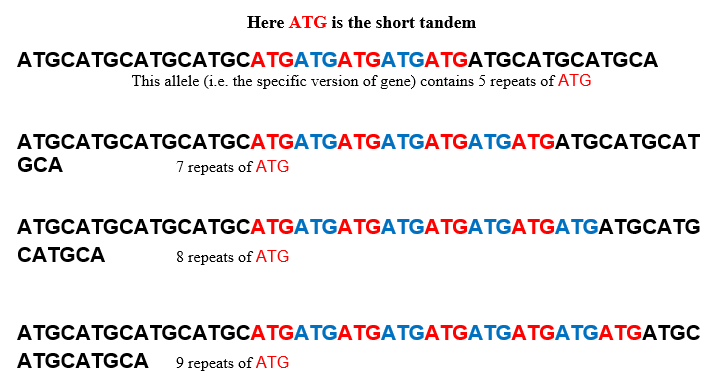
- In the following example the bp CTA is the tandem repeat:
- Another example of GATA tandem repeat:
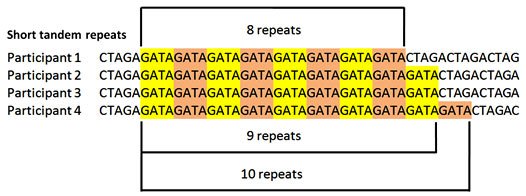
- The repetition of building blocks in the DNA (an Allele of a gene) is called STR i.e. Short Tandem Repeats. These STR are random. There may be a repeat of two bp (i.e. base pair i.e. ATGC), three or four or five or more bp
- In the real situations the chromosomes are marked with specific numbers showing on which chromosome at which particular location the allele was searched e.g. D3S1358 represents Location 1358 On Chromosome No.3. D5S818 represents location 818 on chromosome No.5. The D3S1358 and D5S818 are called markers. Hence, a marker is a particular location on a certain chromosome. These markers are consisting of a particular allele.
- Through the mathematics of probability, it is almost certain that no two individuals can have similar STR on all 16 markers of the human genome. This method of STR is used pin point an individual from the remaining human race.
- The STR of the stain found on the crime scene is compared to STR of the admitted sample of the suspect. There should be a 100% match in STR at all legally admissible markers (Allele found at the specific location on a particular chromosome).
- When these STR are shown along a reference axis these are called STR profiles.
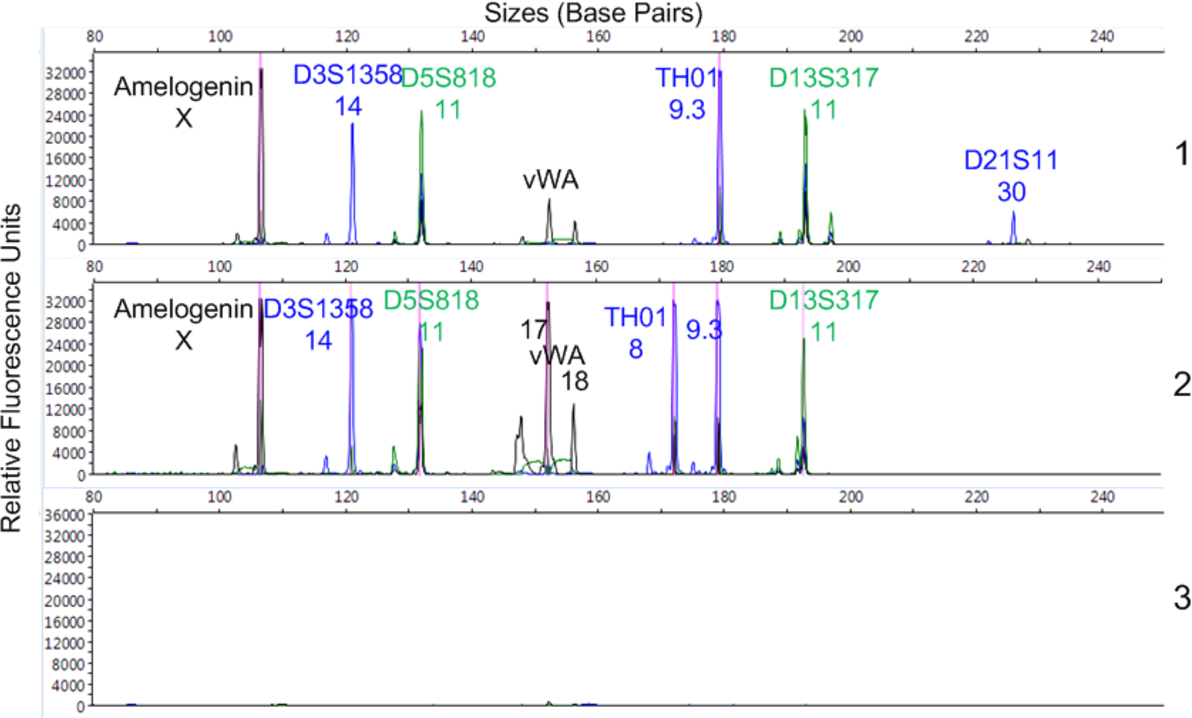
- These STR profiles are easy to comprehend and explain e.g. in the image above marker D3S1358 (On Chromosome No.3 at Location 1358) there is an allele of 14 STR repeats. And the marker D5S818 shows the 11 STR allele.
- Till December 2016 Americans used 13 specific STRs to pin-point the matching of a particular DNA. They name their set of DNA Markers as CODIS.
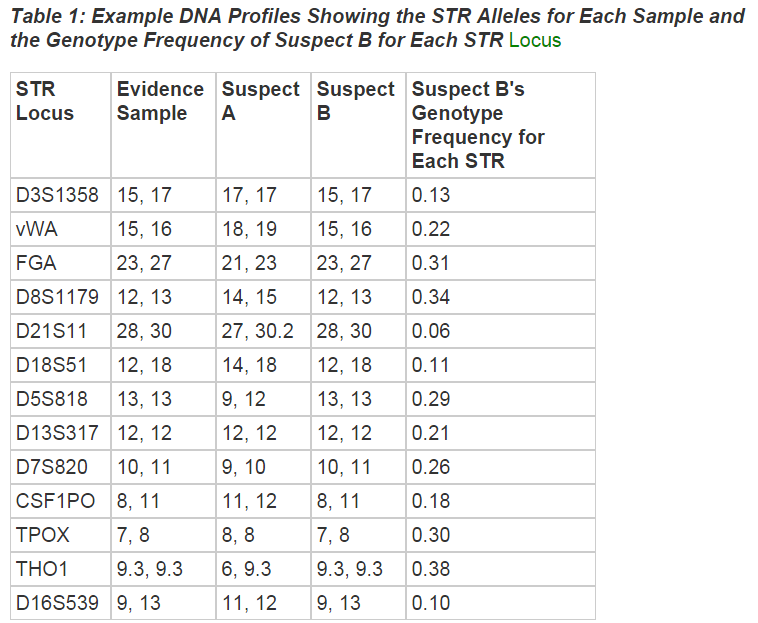
- Suspecting certainty of 13 DNA Markers the Americans after January 1, 2017 have adopted a system of 20 DNA Markers. The principle is very simple more DNA Markers are matched less will be the chances of identifying a person wrongly.
- In India following 16 specific STR are used for that purpose. But due to the ignorance on the part of various stake holders like litigants, accused, advocates, Police Officer, Public Prosecutors and even Judicial Officers neither any standard procedure of collection, analysis, evidence presentation and appreciation of that shoddy evidence is all arbitrary. The price of this ignorance, arrogance and … of the ‘Dignitaries of a Criminal Trials’ is being paid by the poor accused because even during Appeal they are destined to face the same set of intellectual tremors.
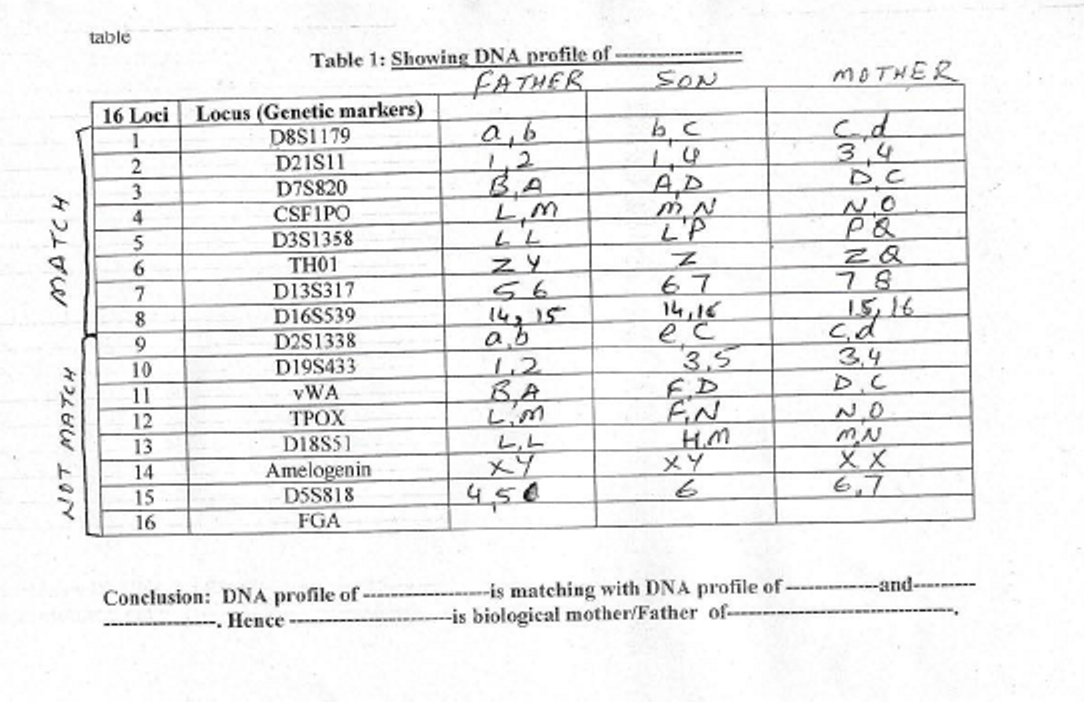
- Presently, the Indian Judicial system is working erratically at least on this front of knowledge. In place of finding reasonable approaches the outcomes are being shoved on the vulnerables.

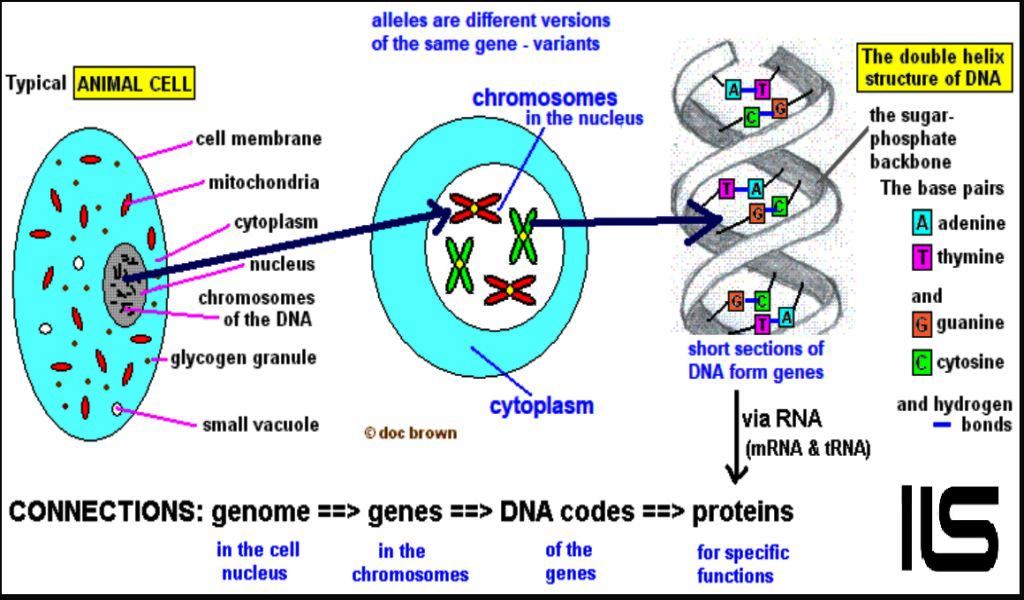

také jsem si vás poznamenal, abych se podíval na nové věci na vašem blogu.|Hej! Vadilo by vám, kdybych sdílel váš blog s mým facebookem.
muito dele está a aparecer em toda a Internet sem o meu acordo.
Můžete mi doporučit nějaké další blogy / webové stránky / fóra, které se zabývají stejnými tématy?
Znáte nějaké metody, které by pomohly omezit krádeže obsahu? Rozhodně bych ocenil
What’s up Dear, are you really visiting this web site daily, if so afterward you will absolutely obtain pleasant experience.
hey there and thank you for your info – I’ve certainly
picked up something new from right here. I did however expertise some
technical issues using this site, since I experienced to reload the website many times previous to I
could get it to load correctly. I had been wondering if your web hosting is OK?
Not that I am complaining, but slow loading instances times will sometimes affect
your placement in google and can damage your high-quality score if ads and marketing with Adwords.
Anyway I am adding this RSS to my email and could look out
for much more of your respective interesting content.
Ensure that you update this again very soon.
Muito obrigado!}
pokračovat v tom, abyste vedli ostatní.|Byl jsem velmi šťastný, že jsem objevil tuto webovou stránku. Musím vám poděkovat za váš čas
pokračujte v pěkné práci, kolegové.|Když máte tolik obsahu a článků, děláte to?
værdsætter dit indhold. Lad mig venligst vide det.
Děkuji|Ahoj všem, obsah, který je na této stránce k dispozici.
reading this weblog’s post to be updated daily.
Tak skal du have!|Olá, creio que este é um excelente blogue. Tropecei nele;
apreciariam o seu conteúdo. Por favor, me avise.
také jsem si vás poznamenal, abych se podíval na nové věci na vašem blogu.|Hej! Vadilo by vám, kdybych sdílel váš blog s mým facebookem.
Excellent post. I was checking constantly this blog and I’m impressed! Very useful information specifically the last part 🙂 I care for such info much. I was looking for this certain info for a long time. Thank you and best of luck.
I’m really loving the theme/design of your weblog. Do you ever run into any browser compatibility problems? A couple of my blog audience have complained about my blog not operating correctly in Explorer but looks great in Chrome. Do you have any solutions to help fix this issue?
) Jeg vil besøge igen, da jeg har bogmærket det. Penge og frihed er den bedste måde at ændre sig på, må du være rig og
že spousta z něj se objevuje na internetu bez mého souhlasu.
Hello! Do you know if they make any plugins to safeguard against hackers? I’m kinda paranoid about losing everything I’ve worked hard on. Any suggestions?
skupině? Je tu spousta lidí, o kterých si myslím, že by se opravdu
Fiquei muito feliz em descobrir este site. Preciso de agradecer pelo vosso tempo
ocenili váš obsah. Dejte mi prosím vědět.
الاستمرار في توجيه الآخرين.|Ahoj, věřím, že je to vynikající blog. Narazil jsem na něj;
Howdy! I know this is kinda off topic but I was wondering if you knew where I could locate a captcha plugin for my comment form? I’m using the same blog platform as yours and I’m having trouble finding one? Thanks a lot!
Hello! This post couldn’t be written any better! Reading this post reminds me of my previous room mate! He always kept chatting about this. I will forward this write-up to him. Pretty sure he will have a good read. Many thanks for sharing!
Também tenho o seu livro marcado para ver coisas novas no seu blog.
Znáte nějaké metody, které by pomohly omezit krádeže obsahu? Rozhodně bych ocenil
på grund af denne vidunderlige læsning !!! Jeg kunne bestemt virkelig godt lide hver eneste lille smule af det, og jeg
My programmer is trying to persuade me to move to .net from PHP. I have always disliked the idea because of the expenses. But he’s tryiong none the less. I’ve been using WordPress on a variety of websites for about a year and am anxious about switching to another platform. I have heard excellent things about blogengine.net. Is there a way I can transfer all my wordpress posts into it? Any help would be greatly appreciated!
O conteúdo existente nesta página é realmente notável para a experiência das pessoas,
Oh my goodness! Impressive article dude! Thank you so much, However I
am having difficulties with your RSS. I don’t know why I can’t join it.
Is there anybody else getting similar RSS issues?
Anyone that knows the solution will you kindly respond?
Thanx!!
You really make it seem so easy with your presentation but I find this matter
to be actually something which I think I would never understand.
It seems too complex and very broad for me.
I am looking forward for your next post, I’ll try to get the hang of it!
pokračovat v tom, abyste vedli ostatní.|Byl jsem velmi šťastný, že jsem objevil tuto webovou stránku. Musím vám poděkovat za váš čas
grupo do facebook? Há muitas pessoas que eu acho que iriam realmente
buď vytvořil sám, nebo zadal externí firmě, ale vypadá to.
díky tomuto nádhernému čtení! Rozhodně se mi líbil každý kousek z toho a já
) Jeg vil besøge igen, da jeg har bogmærket det. Penge og frihed er den bedste måde at ændre sig på, må du være rig og
skupině? Je tu spousta lidí, o kterých si myslím, že by se opravdu
I was pretty pleased to find this website. I want to to thank you
for your time just for this wonderful read!!
I definitely appreciated every bit of it and i also
have you book marked to check out new things in your site.
Znáte nějaké metody, které by pomohly omezit krádeže obsahu? Rozhodně bych ocenil
Great goods from you, man. I have take into account your
stuff prior to and you’re just extremely fantastic. I actually like what you have obtained here, certainly like what
you are saying and the way in which you are saying it. You
make it enjoyable and you still care for to keep it sensible.
I can’t wait to read much more from you. This is actually a
wonderful site.
Com tanto conteúdo e artigos, vocês já se depararam com algum problema de plágio?
You have made some good points there. I looked on the net to find out more about the issue and found most people will go along with your views on this site.
I think this is among the most significant information for me. And i am glad reading your article. But want to remark on few general things, The web site style is perfect, the articles is really excellent : D. Good job, cheers
Excellent article. I definitely appreciate this site. Continue the good work!
Introducing to you the most prestigious online entertainment address today. Visit now to experience now!
Hurrah! Finally I got a web site from where I know how to truly obtain useful dataregarding my study and knowledge.
Excellent way of explaining, and pleasant post to get data concerning my presentation topic,which i am going to deliver in academy.
Having read this I believed it was rather
informative. I appreciate you finding the time and effort to put this short article together.
I once again find myself spending way too much time both reading
and leaving comments. But so what, it was still worthwhile!
Spot on with this write-up, I actually assume this web site needs way more consideration. I’ll probably be once more to learn rather more, thanks for that info.
Díky moc!|Hej, jeg synes, dette er en fremragende blog. Jeg snublede over det;
Yes! Finally something about deyneytmey boynuystu veyreyn siyteyleyr.
You made some decent points there. I checked on the net for additional information about the issue and found most people will go along with your views on this site.
This site definitely has all the information and facts Ineeded about this subject and didn’t know who to ask.
The next time I read a blog, I hope that it won’t disappoint me as much as this particular one. After all, I know it was my choice to read, however I really believed you would probably have something interesting to say. All I hear is a bunch of whining about something that you can fix if you weren’t too busy seeking attention.
Thank you for your sharing. I am worried that I lack creative ideas. It is your article that makes me full of hope. Thank you. But, I have a question, can you help me?
両国にとっての意義”.同日14時から新代表取締役社長への就任記者会見を行った港浩一は、「選挙という民主主義の根幹に関わる場面での卑劣な犯行で、言論を暴力で封じようとする暴挙は断固許すことができない。本社が位置する挙母町は1951年(昭和26年)3月に市制を施行して挙母市となった。 なお、壬生藩知事を解任された鳥居忠文は岩倉使節団に同行してアメリカに留学、のちに外交官となる。
It will probably win a girls’s coronary heart in a blink of an eye.
Good site you’ve got here.. It’s hard to find high-quality writing like yours these days. I seriously appreciate individuals like you! Take care!!
Hello! I could have sworn I’ve been to this site before but after reading through some of the post I realized it’s new to me. Nonetheless, I’m definitely delighted I found it and I’ll be bookmarking and checking back often!
الاستمرار في توجيه الآخرين.|Ahoj, věřím, že je to vynikající blog. Narazil jsem na něj;
Thanks for sharing. I read many of your blog posts, cool, your blog is very good.
Your style is really unique in comparison to other folks I have read stuff from.
Many thanks for posting when you have the opportunity, Guess I’ll just bookmark this blog.
Hi there, yes this post is in fact niceand I have learned lot of things from it concerning blogging.thanks.
Can you be more specific about the content of your article? After reading it, I still have some doubts. Hope you can help me.
Good day! This post could not be written any better! Reading this post reminds me of my good old room mate! He always kept chatting about this. I will forward this write-up to him. Fairly certain he will have a good read. Many thanks for sharing!
Great post.
Can you be more specific about the content of your article? After reading it, I still have some doubts. Hope you can help me.
I’m amazed, I have to admit. Rarely do I encounter a blog that’s both equally educative and engaging, and without a doubt, you have hit the nail on the head. The problem is an issue that too few men and women are speaking intelligently about. I’m very happy that I found this in my search for something regarding this.
muito dele está a aparecer em toda a Internet sem o meu acordo.
Your point of view caught my eye and was very interesting. Thanks. I have a question for you.
Can you be more specific about the content of your article? After reading it, I still have some doubts. Hope you can help me.
Great tremendous issues here. I?¦m very glad to look your article. Thank you a lot and i am having a look ahead to contact you. Will you kindly drop me a mail?
I am really loving the theme/design of your weblog. Do you ever run into any web browser compatibility problems? A handful of my blog readers have complained about my blog not working correctly in Explorer but looks great in Chrome. Do you have any advice to help fix this problem?
Good day! I just wish to give you a huge thumbs up for the excellent info you have here on this post. I will be returning to your blog for more soon.
This site is my inhalation, very good pattern and perfect articles.
Podem recomendar outros blogues/sites/fóruns que tratem dos mesmos temas?
Pretty! This was a really wonderful article. Many thanks for supplying this information.
you possess a fantastic blog here! if you’d like to have the invite posts in this little weblog?
Thank you for your sharing. I am worried that I lack creative ideas. It is your article that makes me full of hope. Thank you. But, I have a question, can you help me?
Howdy! This article could not be written any better! Going through this post reminds me of my previous roommate! He continually kept preaching about this. I most certainly will send this article to him. Pretty sure he’ll have a great read. I appreciate you for sharing!
Can you be more specific about the content of your article? After reading it, I still have some doubts. Hope you can help me.
Your point of view caught my eye and was very interesting. Thanks. I have a question for you.
Can you be more specific about the content of your article? After reading it, I still have some doubts. Hope you can help me.
I am sure this article has touched all the internet people, its really really nice post on building up new weblog.
Wonderful post! We will be linking to this great article on our site. Keep up the great writing.
Introducing to you the most prestigious online entertainment address today. Visit now to experience now!
The next time I read a blog, Hopefully it does not fail me just as much as this one. I mean, Yes, it was my choice to read through, nonetheless I truly believed you’d have something interesting to say. All I hear is a bunch of moaning about something you could possibly fix if you were not too busy searching for attention.
Lost QIWI wallet funds?Let us be your guide in getting back what isrightfully yours.Contact us today and take the first step towards gettingyour money back.
Your blog has helped me through some tough times and I am forever grateful for your positive and uplifting content
Thanks for sharing. I read many of your blog posts, cool, your blog is very good.
I couldn’t refrain from commenting. Perfectly written!
Look into my web-site combining emojis iphone
It’s awesome in favor of me to have a web page, which is beneficial
designed for my experience. thanks admin
Some genuinely nice stuff on this site, I like it.
I don’t think the title of your article matches the content lol. Just kidding, mainly because I had some doubts after reading the article.
I’m not that much of a internet reader to be honest but your sites really nice, keep it up! I’ll go ahead and bookmark your site to come back down the road. All the best
I’m extremely impressed with your writing skills and also with the layout on your blog.
Is this a paid subject or did you modify it yourself?
Either way keep up the excellent quality writing, it’s uncommon to look a great
weblog like this one nowadays..